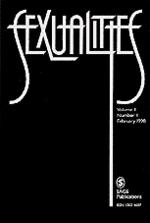Sexualities Special issue: "Researching and Teaching the Sexually Explicit: Ethics, Methodology and Pedagogy"

I am just about to begin teaching a new course in Human Sexuality, so I was excited to review this special issue of Sexualities, the UK-published journal that features new and different voices from sexology, gender studies, and cultural studies. Each of the eight original essays provides teachers, activists and researchers with much-needed breathing space. As Attwood and Hunter point out, “The emergence of ‘porn studies’ in academic institutions has been met with widespread ethical and political opposition, even more so than the study of horror films. Sex media, rather like horror films in fact, are often seen as intrinsically obscene and harmful, effecting real changes in behaviour and attitude, and therefore potentially damaging to researchers and students.” Not so, say the contributors, at least not necessarily so. Porn appears now to be as central to our culture as its study has become prominent to academia.
The collection brings together theorists, educators, and activists from or working in the U.S. (Dennis Waskul), Finland (Susanna Paasonen), Hong Kong (Katrien Jacobs), Australia (Alan McKee, Kath Albury), and the U.K. (Brian McNair, Clarissa Smith, Steve Jones, Sharif Mowlabocus, Feona Attwood, and I.Q. Hunter).
The essays of Waskul, Smith, and McNair will embolden teachers to embrace new media technologies and push the envelope of eroticism in the classroom. Jones and Mowlabocus remind readers that punishing those who enjoy violent depictions of sexuality and/or who sexualize depictions of violence “does not eradicate or significantly hinder the production of such material” but does complicate things for scholars and teachers.
Katrien Jacobs examines the Hong Kong celebrity entertainer Edison Chen, whose DIY pornography made with other Chinese celebrities was inadvertently leaked to the press (darn those computer repairmen!) and led to mass hand-wringing. Paasonen details “something of a porn renaissance” that occurred in late 1990s Finland. Depictions of human sexuality had been regulated since the 1920s until this shift which enabled a wholesale mainstreaming of porn in Finland and other Nordic countries.
Kath Albury trades on her experiences from 2001 to 2003 as the Chief Investigator of the Australian Research Council-funded project, “Understanding Pornography in Australia.” Albury’s first-rate critical reading of porn debates (in this case, in feminist circles) shows that few voices, however radical or conservative, manage to escape the restraints of moralism.
Alan McKee’s “Social Scientists Don’t Say ‘Titwank’” looks at how referees for journals in the humanities and social sciences have responded to his manuscripts about sex. He concludes that “in the humanities there is no longer a problem with the use of vulgar language.” Nevertheless, his essay reveals sharp differences in method, theory, and work-style between practitioners of cultural studies and anthropology. One statement really rankled me: “We surveyed over 1000 consumers of pornography as part of our research. In the correct social science manner, I will now claim this [sic] data as objective.” Other statements in this and other essays, such as “Older respondents had worse attitudes towards women . . . Christians had worse attitudes towards women . . . Those who lived in rural areas had worse attitudes . . .” made me long for the more fine-grained nuances of ethnographic writing about sex, sexuality, and sexual networking. Then again, few ethnographers are doing porn studies or pushing the erotic envelope in the classroom, so readers will find much else of great merit in McKee’s essay and the others.
Given the brevity and accessibility of these eight exciting contributions (not forgetting the six fine book reviews), this newest issue of Sexualities is an especially welcome resource for educators.